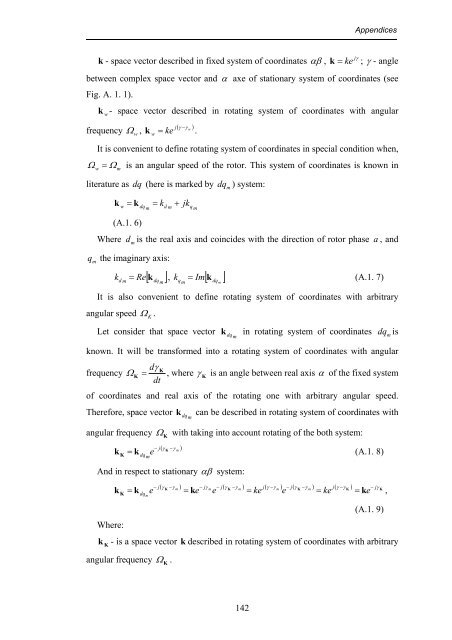Direct Power and Torque Control of AC/DC/AC Converter-Fed ...
Direct Power and Torque Control of AC/DC/AC Converter-Fed ...
Direct Power and Torque Control of AC/DC/AC Converter-Fed ...
Create successful ePaper yourself
Turn your PDF publications into a flip-book with our unique Google optimized e-Paper software.
Appendices<br />
k - space vector described in fixed system <strong>of</strong> coordinates αβ ,<br />
jγ<br />
k = ke ; γ - angle<br />
between complex space vector <strong>and</strong> α axe <strong>of</strong> stationary system <strong>of</strong> coordinates (see<br />
Fig. A. 1. 1).<br />
k<br />
w<br />
- space vector described in rotating system <strong>of</strong> coordinates with angular<br />
frequency Ω<br />
w<br />
,<br />
( γ −γ )<br />
j w<br />
k = .<br />
w<br />
ke<br />
It is convenient to define rotating system <strong>of</strong> coordinates in special condition when,<br />
Ω<br />
w<br />
= Ω m<br />
is an angular speed <strong>of</strong> the rotor. This system <strong>of</strong> coordinates is known in<br />
literature as dq (here is marked by<br />
dq<br />
m<br />
) system:<br />
k<br />
w<br />
= k<br />
dq m<br />
= k +<br />
d m<br />
jk<br />
q m<br />
Where<br />
(A.1. 6)<br />
dm<br />
is the real axis <strong>and</strong> coincides with the direction <strong>of</strong> rotor phase a , <strong>and</strong><br />
q<br />
m<br />
the imaginary axis:<br />
k<br />
d m<br />
= Re[ k ], k Im[ k ]<br />
dq m<br />
qm<br />
= (A.1. 7)<br />
dq m<br />
It is also convenient to define rotating system <strong>of</strong> coordinates with arbitrary<br />
angular speed Ω<br />
K<br />
.<br />
Let consider that space vector k<br />
dq m<br />
in rotating system <strong>of</strong> coordinates dqm<br />
is<br />
known. It will be transformed into a rotating system <strong>of</strong> coordinates with angular<br />
dγ<br />
frequency Ω K<br />
K<br />
= , where γ<br />
K<br />
is an angle between real axis α <strong>of</strong> the fixed system<br />
dt<br />
<strong>of</strong> coordinates <strong>and</strong> real axis <strong>of</strong> the rotating one with arbitrary angular speed.<br />
Therefore, space vector<br />
k<br />
dq m<br />
can be described in rotating system <strong>of</strong> coordinates with<br />
angular frequency Ω<br />
K<br />
with taking into account rotating <strong>of</strong> the both system:<br />
( γ −γ )<br />
− j K m<br />
k K<br />
= k<br />
(A.1. 8)<br />
dqm<br />
e<br />
And in respect to stationary αβ system:<br />
k K<br />
( γ K −γ<br />
m ) − jγ<br />
m − j( γ K −γ<br />
m ) j( γ −γ<br />
m ) − j( γ K −γ<br />
m ) j( γ −γ<br />
K ) − jγ<br />
K<br />
− j<br />
= k e = ke<br />
e = ke e = ke = ke<br />
,<br />
dq<br />
m<br />
Where:<br />
k<br />
K<br />
(A.1. 9)<br />
- is a space vector k described in rotating system <strong>of</strong> coordinates with arbitrary<br />
angular frequency Ω<br />
K<br />
.<br />
142
















![[TCP] Opis układu - Instytut Sterowania i Elektroniki Przemysłowej ...](https://img.yumpu.com/23535443/1/184x260/tcp-opis-ukladu-instytut-sterowania-i-elektroniki-przemyslowej-.jpg?quality=85)
